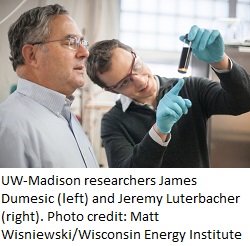 Researchers at the University of Wisconsin-Madison have found a way to get more ethanol out of sugars used in the refining process. This university article says they’re using a plant-derived chemical, gamma valerolactone, or GVL.
Researchers at the University of Wisconsin-Madison have found a way to get more ethanol out of sugars used in the refining process. This university article says they’re using a plant-derived chemical, gamma valerolactone, or GVL.
“With the sugar platform, you have possibilities,” says Jeremy Luterbacher, a postdoctoral researcher and the paper’s lead author. “You’ve taken fewer forks down the conversion road, which leaves you with more end destinations, such as cellulosic ethanol and drop-in biofuels.”
Funded by the National Science Foundation and the U.S. Department of Energy’s Great Lakes Bioenergy Research Center (GLBRC), the research team has published its findings in the Jan. 17, 2014 issue of the journal Science, explaining how they use gamma valerolactone, or GVL, to deconstruct plants and produce sugars that can be chemically or biologically upgraded into biofuels. With support from the Wisconsin Alumni Research Foundation (WARF), the team will begin scaling up the process later this year.
Because GVL is created from the plant material, it’s both renewable and more affordable than conversion methods requiring expensive chemicals or enzymes. The process also converts 85 to 95 percent of the starting material to sugars that can be fed to yeast for fermentation into ethanol, or chemically upgraded furans to create drop-in biofuels.
The researchers are adding liquid carbon dioxide to the mix and could reduce the cost to produce ethanol by 10 percent.

